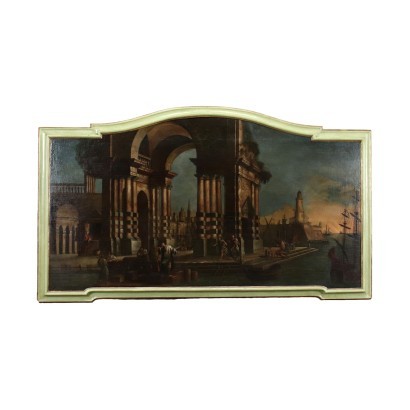ARARPI0129544
Oil on Canvas Attributed to D. Gargiulo Italy XVII Century
Landscape with Architecture and Figures
Oil on canvas. The large landscape is dominated by an imposing architectural structure with columns overlooking the sea, which occupies the entire central part of the canvas, while a fortress is outlined on the right. The scene is then animated by numerous figures of commoners intent on daily activities: in the foreground on the left, on the quay, a group of men awaits the load of numerous crates and trunks. The monogram D.G. This abbreviation, together with the baroque stylistic modality, refers to the attribution to Domenico Gargiulo, stage name of the Neapolitan painter Micco Spadaro (1609/1612 - 1675). Active mainly in Naples, especially in the two decades between the mid-seventeenth century, the Gargiulo established itself mainly as a landscape painter and above all for having documented the tumultuous events of Naples in the seventeenth century (eruptions, epidemics, the revolt of Masaniello). The progressive specialization in the representation of landscapes or city scenes, crowded with figurines presented with minute descriptions and with attention to popular social reality, meant that his commission was mainly of a private nature, receiving commissions from numerous Neapolitan notables, regents, knights and finding his works in all the most important Neapolitan collections of the time. Among its major clients there was also the great Flemish collector Gaspare Roomer, to whom the Gargiulo owed its fortune. Gargiulo often inserted his abbreviations in his works, but rarely dated them; it was possible to establish the dating of his production only thanks to the realization of a series of works for the monks of the Certosa di S. Martino, which took place between 1638 and 1646, among the few religious works he made but the only ones in be documented with some accuracy. The large canvas proposed here is presented in a stylish frame.













